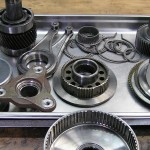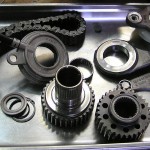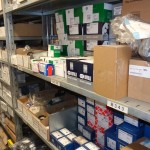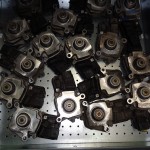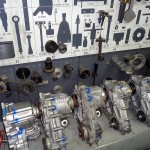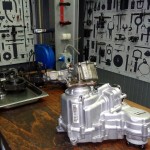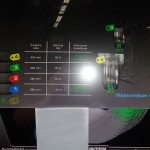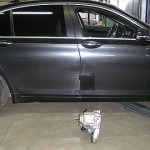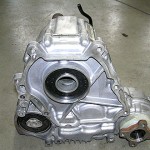Regeneration of ATC VTG distribution boxes
Why do ATC VTG distribution boxes of BMW and other four-drive car brands spoil?
At the beginning I want to describe the symptoms of five common problems.
First problem is “jerking attaching of the drive” – during steady driving nothing happens, but only when we start to accelerate the 4WD car attaches the front wheel drive for increases the adhesion. When everything is in order, this process is negligible. Auto accelerates forward like a slingshot.. in the spoiled (loose) drive depending on pressing of the gas pedal jerking forward-back are starting to appear, with the little gas less and with the big gas bigger, it is the effect attaching the front wheel drive with a delay or advance of attaching. It is very dangerous on slippery surfaces.
Second problem is „rigid attaching”. It manifests itself when driving on squares and for narrow entrances at multilevel parking. In this case, shots are heard very loudly usually in the back of the car. „Rigid attaching” is leading to very large overload in the drive transmission system. This is very destructive to the car and dangerous for all road users. The photo 1 shows a broken front drive shaft, which undercut the frame side member and broken of the engine oil pan.

photo 1
Third problem is rhythmic jumping during the acceleration, pulling a trailer and on driveways. It is a jumping of the chain in the distribution box.
Fourth problem is howling of the box due to long work on the old oil, or lack of the oil.
Fifth problem in VTG distribution boxes of the old type is the „Christmas tree”. I named it so because during its occurrence all control lights on the dashboard light. This is caused by damage of the plastic rack of the VTG adjusting motor. The scope of work of the rack is 180 degrees. In the whole world this failure is removed by exchanging the rack or rotating it by 180 degrees. It is effective in about 15 percent of cars. This rack is a protection for the distribution box. When inside the distribution box friction is too large the rack may damage. With years of my experience it result that when the rack is crushed immediately the box should be disassembled for verification of their condition. Usually cars come with the “Christmas tree” from foremans with the rotated rack in the adjusting motor in such the condition that they are suitable only for scrap. This begs the question: why do these drives failure? Let’s start from scratch. Let’s imagine a small bike. The bike has a large rear wheel and the small front wheel. Both wheels have 15 teeth chain gears chain identical for the front and rear wheel. These racks are connected by the chain. When we start to push the bike forward, the front wheel will want to do a lot of turnover and the rear wheel will want to do a low of turnover. The effect of pushing the bike forward is jerking of the chain to its breaking. The same applies to cars. Everyone in the market say to me that they have the checked wheels of the same size. Oh but bloomer, e.g. Pirelli P Zero with size 225x45x17 in the front of the car and the Pirelli P Zero 225x45x17 in the rear of the car does not have the same circumference of wheels. Why? Because they are usually tires dedicated for the car manufacturer’s brand. For example, the Pirelli P Zero 225x45x17 with centimeter stamp of the star (dedicated for BMW) has a different circumference than the Pirelli P Zero 225x45x17 labeled MO (Mercedes). This is the reprehensible mistake of most companies replacing tires. And when we replace only two tires from savings we bear costs of repair of the reducer in the 4×4 car. Imagine that you’re going from Warsaw to Wroclaw and the difference in the circumference of the wheels is 20 mm, after 100 revolutions you have the difference of two meters. And what happens at 400km? Smaller front wheels are still on the road and the rear of the car arrived at the place, as you think what your drive on it? Replacing two tires, even identical, in the car is too big difference in the circumference. This leads to the destruction of the distribution box and the rest of the drive. Pumping of wheels like a prosaic task. It is very complicated, especially in Poland. At the stations usually measure gauges in the gun to pump the wheel are. Operators of the station have no control on the blower. People frustrated by setbacks in life throw on the earth the measuring instrument thus meter calibration is wrong. Remember never to use this S…t. The only real pressure measurement we get from the device that has only the plug on the valve wheel and the measurement is shown in the pumping station. At the gas station, you can request the certificate of device calibration. From this it depends not only on the security of your distribution drive but your life! If you pump only one wheel using blower with a gauge in hand it is likely that rather than pump 2,2 bar you will pump 3.5 bar, yet only a small hole and tragedy is ready.
The Mine is undetectable!
The next spoil-foreman spoil of your beloved four-wheel-driven cars is a vehicle inspection station. When you drive onto rolls (measurement of the braking force) the front axle, the device must be capable for four-wheel-driven cars. And what does it mean? When measuring e.g. front wheels can not turn in the same direction. When your distribution of the drive will not be fully disengaged it may be damaged. Diagnostic lines have the function of control of 4WD cars through the reverse run of left and right wheels. The difference is leveling on the driving axle (pay attention on the lock of driving axles). 4 WD cars are more complicated than cars with one driven axle but thanks to this the drive given from four wheels is much more powerful than from two. If what I have written will save on the cost of at least some of the owners of these cars it is still a great success.
Witold Stando



